While passing through Carolina Beach, I met a fellow cruiser who had rigged his previous boat with synthetic standing rigging. He has since sold his ketch and moved onto a gorgeous wooden motor yacht. We got talking and he told me his innovative and wonderful method of tensioning his synthetic standing rigging.
Instead of setting up a complicated pulley system that leads to a deck winch, he simply took a different tool and made his life easier. He used an electric fence wire tensioner. These tensioners cost him around $2 and are made of plastic. (http://www.kencove.com/fence/Wire+Tighteners_detail_SSDR.php) They lasted him a few years and were innexpensive enough to simply replace when the sun weakened them.
The only caveat to this system is that you need a special tool that is used to tighten the wires with these devices. The tool has a square end that inserts into the device and has long handles on it. The handles are long enough that he felt it easy to tension his standing rigging without over exerting himself.
To tension his rigging, he would tighten the lashings by hand as much as he could and then tie them off. He then slipped the plastic tensioner onto one of the lashings and set it in the slot that is cut for a wire to pass through.
With the tensioner slipped over the lashing, he would then insert the tool and begin winding the lashing around the tensioner. This system is genius because it uses a massive leverage advantage to collect the lashing line and generate the tension needed. This not only makes it easy to setup the rigging, but also quick to adjust the standing rigging as all you need to do is insert the tool and spin it as needed!
Once the tension needed is achieved, a simple pin is inserted to hold everything in place. The pin prevents the tensioner from spinning and unspooling, holding your rigging in place! There are no knots to tie or pulley systems to setup. Simply insert the tool into the key hole and spin until its perfect!
Yes, the tensioner is made out of plastic and dies after a few years, but the unit costs around $2 and is easy and cost effective to replace when compared to all the time that it will take to tension your standing rigging using the Shroud Frapping Knot.
If you are considering switching to synthetic standing rigging but concerned that the Shroud Frapping Knot is too complicated for you to learn, this is an easy alternative that achieves the same result of a properly tuned rig with much less involvement and effort.





